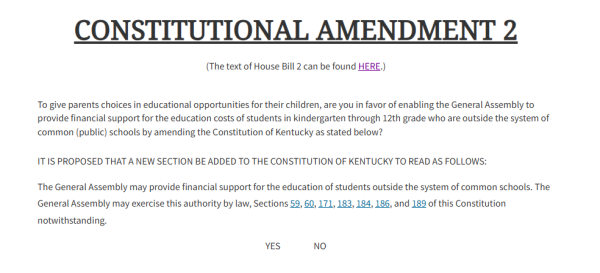Election Day is nearing, and with that often comes some sort of election preparation. Whether it is to know where to vote or to know what is on the ballot, there are still questions many of us are trying to answer.
If you are voting in Kentucky, one of those questions probably is, “What is Amendment 2?”
Yard signs all over the state read “Yes for 2” and “No for 2,” but what is everyone actually talking about?
These signs are referencing one of two constitutional amendments on the ballot this year in the state of Kentucky. The first amendment on the state’s ballot this year addresses the clarity of the language currently prohibiting noncitizens from voting.
Amendment 2 addresses the funding of schools outside of the “system of common schools.”
A “common school” is any school inside of Kentucky’s 171 current public school districts.

This amendment, often referred to as “school choice,” would add the following sentence to seven sections of Kentucky’s Constitution:
“The General Assembly may provide financial support for the education of students outside the system for common schools.”
Three of the sections this would be added to are sections 183, 186 and 189.
Section 183 currently reads “ The General Assembly shall, by appropriate legislation, provide for an efficient system of common schools throughout the State.”
Section 186 states that the funds in question “be held inviolate for the purpose of sustaining the system of common schools.”
Finally, Section 189 states that public funds or taxes may not be used by, or to aid, “any church, sectarian or denominational school.”
Those for the change say that it would allow parents to use the money allotted for their child currently in the public school system to pursue any schooling they choose—this includes charter and private schools.
One group supporting the amendment is EdChoice Kentucky. According to their website, they believe school choice is important because “some children might succeed at their assigned public school, while others fit in better in a different environment.”
Those against the amendment feel that the changes would take funding away from current public school funding. There are also concerns with the fact that similar legislation has been deemed unconstitutional in the past. According to a WLWT article from Oct. 16, Kentucky Governor Andy Beshear said “I am fully opposed to Amendment Two. I am going to vote no against Amendment Two and I’m going to do everything I can to defeat it.”
The Kentucky Board of Education passed a resolution on Oct. 7 in opposition of “any legislation or policy that would allocate state dollars to fund schools outside the common system of public schools.”
Currently, 21 U.S. states have at least one private school choice program, and 12 states have at least one that is universally accessible. Ten states have vouchers.
Ohio currently has five voucher programs that are deemed for specific students as well as a universal tax-credit scholarship program. Indiana has a universal voucher program and tax-credit program that is open to almost all students.
Indiana also has an education savings account (ESA). What makes an ESA program different from a voucher program is that the money from an ESA can be used for any school expenses, not just tuition. Indiana’s ESA is designated for students with disabilities.
While Amendment 2 would not immediately create these programs or vouchers in Kentucky, it would allow for the creation of them in the future.
With such varying opinions on the matter, discourse around Amendment 2 is likely to continue right up to Election Day, but the decision is in the hands of Kentucky’s voters on Nov. 5.




